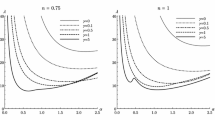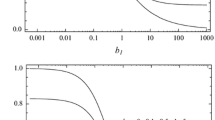Abstract
Critical Rayleigh numbers determined by linear stabiliy theory are presented for porous-fluid layers of infinite horizontal extent heated internally by a uniform volumetric energy source in the fluid. The thermal coupling between the layer and its environment is represented by a general mixed boundary condition for both the conduction state and the disturbance temperature. Rigid-rigid, rigid-constant pressure, and constant pressure-rigid boundaries are considered in the computations. For a fixed ratio of upper surface Biot number to that at the lower surface, decreasing the Biot number is strictly destabilizing for values of this ratio greater than or equal to one. A layer with a rigid upper surface is generally the most stable; however, a layer with a rigid upper surface and a constant pressure lower surface exhibits the largest values of critical Rayleigh numbers for large values of Biot number.
Zusammenfassung
Mit einer linearen StabilitÄtstheorie wurden kritische Rayleigh-Zahlen für poröse Schichten unendlicher horizontaler Ausdehnung bei innerer Heizung mit konstanter Leistungsdichte bestimmt. Die thermische Kopplung zwischen Systemen und Umgebung besorgt eine gemischte Randbedingung sowohl für den Fall der WÄrmeleitung als auch für die Umschlagstemperatur. Die Begrenzungen haben folgende Eigenschaften: oben und unten fest, oben fest und unten konstanter Druck und umgekehrt. Für ein festes VerhÄltnis der Biot-Zahlen oben und unten wirkt abnehmende Biot-Zahl destabilisierend, wenn dieses VerhÄltnis grö\er oder gleich Eins ist. Am stabilsten ist eine Schicht mit fester oberer Begrenzung; dagegen besitzt eine Schicht mit fester oberer Begrenzung und konstantem Druck unten die grö\ten kritischen Rayleigh-Zahlen für hohe Biot-Zahlen.
Similar content being viewed by others
Abbreviations
- a:
-
overall wave number of plan form of disturbance velocity and temperature
- Bio :
-
Biot number, hL/km
- c:
-
specific heat at constant pressure
- C:
-
the ratio (ρc)m/(ρc)f
- D:
-
differential operator, d/dZ
- F(x,y):
-
plan form of disturbance motion
- g :
-
gravitational acceleration, (0,0,-g)
- h:
-
convective heat transfer coefficient on exterior of layer surface
- Hm :
-
mean value of volumetric energy generation rate, energy/unit volume of fluid-porous material — time
- kf :
-
thermal conductivity of fluid
- km :
-
mean thermal conductivity ϕkf + (1ψ)ks
- kr :
-
thermal conductivity ratio, km/kf
- ks :
-
thermal conductivity of solid
- L:
-
height of fluid-porous layer
- p:
-
pressure
- p′:
-
disturbance pressure
- RD :
-
Rayleigh number, Equation (14)
- t:
-
time
- T:
-
conduction state temperature
- ul′:
-
disturbance velocity, (u′,v′,w′)
- U:
-
fluid velocity
- UQ :
-
seepage velocity
- W(Z):
-
vertical component of w′
- x,y:
-
horizontal coordinates
- z:
-
vertical coordinate, 0 ⩽z ⩽L
- Z:
-
dimensionless vertical coordinate, z/L
- αf :
-
thermal diffusivity of fluid
- γ:
-
Biot number ratio, Bi1/Bi0
- Β:
-
isobaric coefficient of thermal expansion of the fluid
- θ′:
-
disturbance temperature
- θ(Z):
-
vertical component of disturbance tempe ratur
- χ:
-
permeability of porous material
- λ:
-
function defined by Equation (9)
- Νf :
-
kinematic viscosity of fluid
- ρ:
-
density
- (ρc)m :
-
mean volumetric heat capacity (ρc)fϕ + (1 ϕ)(ρc)S
- σ:
-
decay constant of disturbance velocity and temperature
- ϕ:
-
porosity of porous material
- m:
-
mean value
- s:
-
solid value
- f:
-
fluid value
- o:
-
value at Z=0
- 1:
-
value at Z=1
- c:
-
critical value
- r:
-
reference value
References
Lapwood, E.R.: Convection of a Fluid in a Porous Medium. Proc. Camb. Phil. Soc.44 (1948) 508
Sun, Z.S.; Tien, C.: Onset of Convection in Porous Medium Containing Liquid with a Density Maximum. Proc. Fourth Int. Heat Trans. Conf., Paris, 1970, Paper N.C. 2.11
Rogers, F.T.; Schilberg, L.E.; Morrison, H.L.: Convection Currents in Prous Media, IV. Remarks on the Theory. J. Appl. Phys.,22 (1951) 1476
Muskat, M.: Flow of Homogeneous Fluids Through Porous Media, New York: McGraw-Hill 1937
Pellew, A.; Southwell, R.V.: On Maintained Convective Motion in a Fluid Heated From Below. Proc. Roy. Soc. (London)176A (1940) 312
Ramchandani, R.: Thermal Instability in Porous Fluid Layers Heated from Within. M.Sc. Thesis, Ohio State University 1974
Sparrow, E.M.: On the Onset of Flow Instability in a Channel of Arbitrary Height. J. Appl. Math. Phys.15 (1964) 838
Sparrow, E.M.; Goldstein, R.J.; Jonsson, V.K.: Thermal Instability in a Horizontal Fluid Layer; Effect of Boundary Conditions and Nonlinear Temperature Profile. J. Fluid Mech.18 (1964) 513
Sani, R.L.: Convective Instability. Ph.D. Thesis in Chemical Engineering, University of Minnesota, 1963
Nield, D.A.: Surface Tension and Buoyancy Effects in Cellular Convection. J. Fluid Mech.19 (1964) 341
Hurle, D.T.J.; Jakeman, Z.; Pike, E.R.: On the Solution of the Bénard Problem with Boundaries of Finite Conductivity. Proc. Roy. Soc. (London)296A, 1447 (1967)
Kulacki, F.A.: Thermal Convection in a Horizontal Fluid Layer with Uniform Volumetric Energy Sources. Ph.D. Thesis in Mechanical Engineering, University of Minnesota, 1971
Author information
Authors and Affiliations
Rights and permissions
About this article
Cite this article
Kulacki, F.A., Ramchandani, R. Hydrodynamic instability in a porous layer saturated with a heat generating fluid. Wärme- und Stoffübertragung 8, 179–185 (1975). https://doi.org/10.1007/BF01681559
Received:
Issue Date:
DOI: https://doi.org/10.1007/BF01681559




